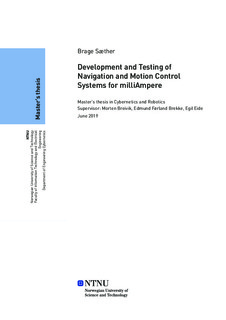| dc.contributor.advisor | Breivik, Morten | |
| dc.contributor.advisor | Brekke, Edmund Førland | |
| dc.contributor.advisor | Eide, Egil | |
| dc.contributor.author | Sæther, Brage | |
| dc.date.accessioned | 2019-10-31T15:07:14Z | |
| dc.date.issued | 2019 | |
| dc.identifier | no.ntnu:inspera:35771502:14928046 | |
| dc.identifier.uri | http://hdl.handle.net/11250/2625696 | |
| dc.description.abstract | Marine fartøy som opererer i trange omgivelser krever et robust og nøyaktig navigasjonssystem og kontrollsystem. Denne oppgaven presenterer nye implementasjoner av navigasjonssystem og kontrollsystem i detalj. Implementasjonene utforsker det siste og beste innen hver av sine respektive fagområder, samt implementasjon av disse på en eksperimentell plattform.
Det nye kontrollsystemet tar i bruk $\mathcal{L}_1$ adaptiv kontroll basert på adaptiv backstepping for raskere konvergeringstid for estimeringen av dynamikk som ikke er modellert. Det nye kontrollsystemet fungerer sammen med et \gls{eskf} som utfører sensor fusjon og tilstandsestimering. Disse systemene fungerer som oppgraderinger av det gamle navigasjonssystemet og kontrollsystemet på den eksperimentelle plattformen milliAmpère.
Det nye navigasjonssystemet og kontrollsystemet er testet i simulatorer og gjennom eksperimentelle tester i havnebassenget ved Brattøra i Trondheim. De nye implementasjonene bruker de eksisterende systemene for å foreta sammenligninger i ytelse. En rekke ytelses metrikker er tatt i bruk for en objektiv evaluering av de ulike implementasjonene.
De nye systemene er testet både individuelt og samlet for å skaffe et bilde av hvilke konsekvenser de ulike systemene har på overordnet ytelse. De nye implementasjonene fungerer bedre enn de eksisterende implementasjonene. Det nye kontroll systemet øker evnen til å estimere dynamikk som ikke er modellert betraktelig, og det nye navigasjonssystemet fjerner flere uønskede egenskaper som var tilstede i det gamle navigasjonssystemet. Spesielt oppleves det en økning i retningsstabilitet som en konsekvens av de nye systemene. Til slutt er de nye systemene sydd sammen med en kollisjonsunngåelsesmodul som er utviklet av en felles student. Suksessfulle full skala tester med disse tre systemene som jobber sammen er utført med virtuelle objekter. Disse testene markerer en fullstendig oppgradering av planlegging, navigasjon og kontroll systemet på den eksperimentelle plattformen. | |
| dc.description.abstract | Marine vessels operating in a confined area demands a robust and accurate navigation and control system. This thesis presents the implementations of a navigation system and a motion control system. The implementations in the thesis explore two state of the art methods in their respective fields and their implementations on an experimental platform.
In the implementation of the new motion control system, the $\mathcal{L}_1$ adaptive control approach utilizes adaptive backstepping for faster convergence of the unmodeled dynamics. The latest motion control approach is coupled with an \gls{eskf} that performs sensor fusion and state estimation. Together these approaches serve as an upgrade over the prior systems on the experimental platform milliAmpere.
The new navigation system and motion control system are both tested through computer-simulated environments and experimental tests in the harbor basin by Brattøra in Trondheim. The new implementations use the existing implementations on the experimental platform for a comparison of performance. Various performance metrics ensure an objective assessment of performance between the new and old implementations.
The new implementations are tested individually at first to get a grasp of how they differ in performance in comparison to the prior system. Afterwards, they are joined together to show the performance with their combined efforts. The new implementations outperforms the prior solution. The new motion controller greatly increases the ability to estimate the unmodeled dynamics, and the new navigation system successfully eliminates several unwanted characteristics present in the previous implementation. The new implementations especially improves the directional stability of the vessel. Lastly, final experimental tests with a collision avoidance module, which is developed by a fellow student, are successfully carried out with virtual objects. The experimental tests with the use of the collision avoidance system mark the complete upgrade of the new \gls{gnc} system. | |
| dc.language | eng | |
| dc.publisher | NTNU | |
| dc.title | Development and Testing of Navigation and Motion Control Systems for milliAmpere | |
| dc.type | Master thesis | |
